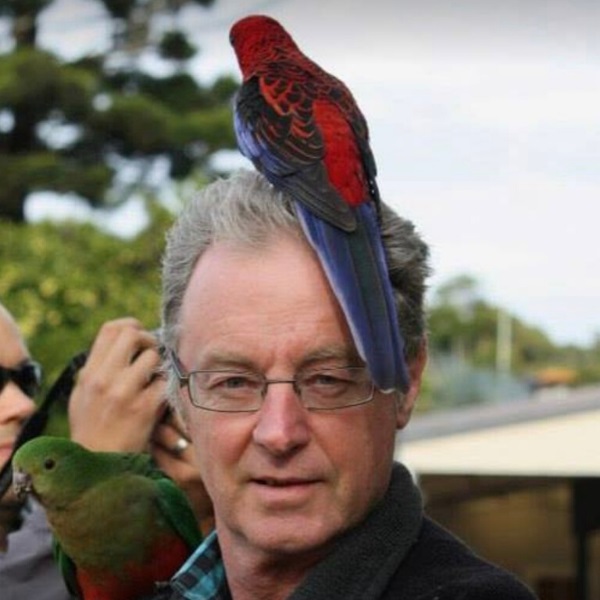10 June 2020
Bird feeding is an increasingly popular activity with an estimated 30-60 per cent of Australian households feeding backyard wild birds. But is it a good idea?
Wildlife Queensland recently caught up with urban ecologist and pioneering researcher in bird feeding, Professor Darryl Jones, to chat about this somewhat contentious subject.
WPSQ: Thank you for joining us, Darryl. Feeding wild birds is a popular activity for many Australians. But is it wrong?
Darryl: Feeding wild birds can be a pleasure, a privilege and also a powerful responsibility. To pronounce this practice as simply ‘wrong’ misses some extremely important points.
First, the overwhelming majority of people who feed birds care deeply and often passionately about ‘their’ birds. Second, there are a lot of feeders. Millions of Australians feed wild birds in their gardens every day. Numerous studies indicate that somewhere between 30 and 60 per cent of Australian households spend money on food to be offered to wild birds.
But there are also some genuine concerns that we have to address. One of the main issues, expressed by both opponents and proponents of bird feeding, is that our provisioning of bird food can lead to dependence, with the birds relying on people instead of foraging naturally. Thankfully, there is very little evidence for this. Apart from extreme situations such as prolonged cold periods or drought, most birds visiting feeders obtain only a small proportion of their daily diet this way; most of their food remains entirely natural.
Even when birds have access to lots of feeders, they still prefer to gather most of their food from natural sources. This is especially the case with the food they bring to nestlings; this is almost never artificial.
And to be completely frank: the birds don’t need this food – or us – at all! It may be tough to accept, but our feeders are more for us than them.
WPSQ: 30-60 per cent of Australian households … that’s a huge number! Why do you think such a large percentage of Australians feed birds?
Darryl: Yes, those figures were a complete surprise, but they do mean that feeding is one of the most significant means by which humans interact with nature, especially in cities. There is something especially profound about direct contact with genuine wildlife. By simply filling a feeder truly wild creatures can enter our lives. For many people, that is an experience of enormous significance.
WPSQ: The topic of bird feeding is very controversial in Australia though, isn’t it? This is not the case in other countries where feeding is practised and indeed promoted by many respected conservation and bird organisations as a form of conservation. Why is this unique to our country?
Darryl: This is certainly true but just why it is such a big deal here is still something I don’t fully understand. All of the familiar reasons people give for opposing feeding birds in Australia – dependency, spreading disease, helping the species that are already common and others – are concerns everywhere in the world, yet the level of opposition here is much higher than anywhere else. One element may be that in the Northern Hemisphere, feeding started as a way of helping obviously suffering birds during the harsh winters, something that is not really a feature here.
One of the unfortunate legacies of the strong opposition to feeding here has been the lack of Australia-specific information or advice on offer to tell them how to feed birds properly. There is nowhere that concerned feeders can find reliable information. That’s what prompted me to write Feeding the Birds at Your Table[i].
WPSQ: What advice do you have for people wishing to feed wild birds?
Darryl: Well, a good start would be to read my book, Feeding the Birds at Your Table! (laughs)
If you want to assist wild birds at your place, here are some key tips:
- Growing a variety of native plants is not only a form of bird feeding but it provides habitat and cover for them to live.
- The idea is not to think you are providing a meal; it’s just a snack. Even if they pay a visit, its good to know that most of their diet will still be natural.
- Although seed mixes are common, you can attract many different species by putting out a variety of edible things: nuts, berries, chopped fruit, and even frozen peas and corn all work.
- Although a lot of people offer mincemeat to magpies and kookaburras, we now know this can be harmful.
- If you provide seed, buy a high-quality mix produced by a pet food company.
- Finally, always make sure your feeder is thoroughly cleaned every day.
More information
Feeding the Birds at Your Table is the ultimate practical guide to feeding birds safely in Australia. Included are profiles of different types of Australian birds that are found in urban areas, with information on what is appropriate to feed them without causing harm, the best feeders to use, and advice on how to create a bird-friendly garden.
About Darryl Jones
Prof Darryl Jones is Professor and Deputy Director of the Environmental Futures Research Centre at Griffith University (Australia). He has been investigating the process of urbanisation and its effects on biodiversity for over three decades, with a special focus on why some species are successful in cities and others, are not.
He is a pioneering researcher in bird feeding and has written extensively on the subject (the first book on global bird feeding, The Birds at My Table, came out in 2018). His latest book, Feeding the Birds at Your Table, was shortlisted for the 2020 ABIA Small Publisher’s Adult Book of the Year.
[i] Jones, D., 2019. Feeding the Birds at Your Table: Guide for Australia. NewSouth Publishing, Australia.

